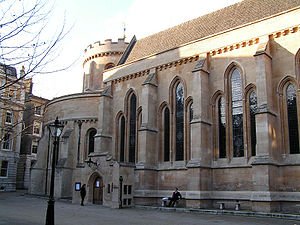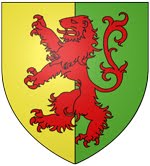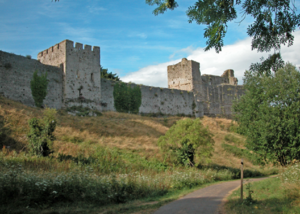| Magna Carta Surety Baron William Marshal was one of the twenty-five medieval barons who were surety for Magna Carta in 1215. Join: Magna Carta Project Discuss: magna_carta |
Note - see Disambiguation (below)
Contents |
Biography
Birth
William Marshal was the son of William Marshal and Isabel de Clare.[1][2][3] He was born in about 1190 in Normandy.[2]
Life
From 1205 to 1212 William was held by King John as a hostage for his father's loyalty.[1][2]
In early 1215 William joined the group of Barons who went on to compel King John to agree to the Magna Carta, of which he was one of the Sureties. (His father was one of the Illustrious Men who advised King John.) Along with other rebel Barons, he was excommunicated in December 1215.[1][2] He continued in rebellion, giving homage to Prince Louis of France in May 1216.[1][2][3] In the autumn of 1216 he abandoned Louis. He helped to capture Winchester, Southampton and Marlbrorough Castles for the government of Henry III, and fought against the rebels in the Second Battle of Lincoln in May 1217.[1][2]
In 1219 his father died and William inherited the Earldom of Pembroke and the office of Marshal of England.[2][3] The following year he granted his lands in Normandy to his brother Richard.[1][2] William's inheritance included extensive lands in Wales, the Marches and elsewhere.[1] They included half the Barony of Long Crendon, Buckinghamshire[4] and Chepstow, Monmouthshire.[5]
In 1220 William went to Ireland, returning to Wales in 1221. He went back to Ireland in 1222.[3] In 1223 he was back again in Wales, recapturing castles and forcing Llywelyn the Great to come to an agreement;[3] he was made Constable of Carmarthen and Cardigan Castles.[2] From 1224 to 1226 he was Justiciar of Ireland.[1][2]
In 1230 William went with Henry III to fight in Brittany and France.[2]
Religious Donations
William was a major benefactor of a number of religious establishments, including Tintern Abbey (Monmouthshire), Mottisfont Abbey (Hampshire), Kilkenny Friary (Ireland) and St Paul's Cathedral.[2]
Marriages
William married twice, but had no children.[1][2] His first wife was Alice de Bethune: they married in 1214.[1][2][6] She probably died in about 1216.[1][2] She was buried in St Paul's Cathedral, London.[3] His second wife was Eleanor, daughter of King John: they were married in 1224.[1][2][3][6]
Death
William died on 6 April 1231[1][2][3] at Fawley, Hampshire.[3] He was buried on 15 April beside his father in the Temple Church, London.[1][2][6] His widow became a nun, but subsequently married Simon de Montfort[2] on 7 January 1237/8 (1238 in modern reckoning).[1]
Coat of Arms
William Marshal carried his father's coat of arms: parti per pale or and vert, lion rampant gules.[7]
Research Notes
Disambiguation
Care should be taken to distinguish the William Marshal of this profile from his father of the same name, William Marshal, who was one of the Illustrious Men who were King John's Counsellors at the time of the Magna Carta.
Name; Office of Marshal
The family name is normally spelt Marshal, from Norman French Mareschal. The family served its name from the hereditary office of Marshal. "Marshal" originally referred to a function of "horse servant", which is what the word meant in the old language of the Franks. By William's lifetime, the work of the king's Marshal had grown far away from its original tasks. There were thus many marshals, but William's family held the highest marshalcy in the royal household. The office became hereditary in the time of William's father.[8][9]
Duties of the Master Marshall "involved the keeping of certain royal records" and the management of "four other lesser marshals, both clerks and knights, assistants called sergeants, the knight ushers and common ushers of the royal hall, the usher of the king's chamber, the watchmen of court, the tent-keeper and the keeper of the king's hearth".[10][11]
Death Place
Professor Saul's biography for the 800th anniversary of the Magna Carta gives William's death place as London.[12] Cawley's Medlands gives it as Fawley near Marlow, Buckinghamshire, citing the Annals of Tewkesbury Abbey.[3]
Magna Carta 800th Anniversary Biography
For the 800th anniversary of the Magna Carta in 2015, Professor Nigel Saul wrote a set of biographies of the Surety Barons. He and the Magna Carta 800th Anniversary Committee generously gave permission for them to be reproduced on WikiTree. They can be viewed here.
Sources
- ↑ 1.00 1.01 1.02 1.03 1.04 1.05 1.06 1.07 1.08 1.09 1.10 1.11 1.12 1.13 1.14 Douglas Richardson. Royal Ancestry: A Study in Colonial and Medieval Families, 5 vols, ed. Kimball G. Everingham. Salt Lake City: the author, 2013. See also WikiTree's source page for ‘’Royal Ancestry’’. Vol. IV pp. 42-44, MARSHAL 3.i
- ↑ 2.00 2.01 2.02 2.03 2.04 2.05 2.06 2.07 2.08 2.09 2.10 2.11 2.12 2.13 2.14 2.15 2.16 2.17 2.18 G E Cokayne. Complete Peerage, revised edition, Vol. X, St Catherine Press, 1945, pp. 365-368, PEMBROKE V
- ↑ 3.0 3.1 3.2 3.3 3.4 3.5 3.6 3.7 3.8 3.9 Charles Cawley. 'Medieval Lands', entry for William Marshal d. 1231
- ↑ I J Sanders. English Baronies, a Study of their Origin and Descent 1086-1327, Clarendon Press, Oxford, 1960, p. 63
- ↑ I J Sanders, English Baronies, p. 111
- ↑ 6.0 6.1 6.2 Oxford Dictionary of National Biography, entry for 'Marshal, William, fifth earl of Pembroke (c. 1190–1231)'
- ↑ Ian Heath. Armies of Feudal Europe 1066-1300, Lulu.com, 2016, p. 240, Google Books, accessed 12 April 2020
- ↑ Wikipedia: Earl Marshal
- ↑ Wikipedia: John Marshal (Marshal of England)
- ↑ D Crouch, William Marshal: Knighthood, War and Chivalry 1147-1219, 2nd edition, Routledge, 2002
- ↑ From a treatise of 1136 made for King Stephen, describing the duties of the Marshal.
- ↑ Copy here on WikiTree
- Richardson, Douglas. Royal Ancestry: A Study in Colonial and Medieval Families, 5 vols, ed. Kimball G. Everingham. Salt Lake City: the author, 2013. See also WikiTree's source page for ‘’Royal Ancestry’’. Vol. IV pp. 42-44, MARSHAL 3.i
- Cokayne, G E. Complete Peerage, revised edition, Vol. X, St Catherine Press, 1945, pp. 365-368, PEMBROKE V
- Oxford Dictionary of National Biography, entry for 'Marshal, William, fifth earl of Pembroke (c. 1190–1231)', print and online 2004, revised online 2005, available online via some libraries
- Dictionary of National Biography, 1885-1900, entry for 'Marshal, William (d.1231)', Vol. 36, pp. 233-234, Wikisource
- Cawley, Charles. "Medieval Lands": A prosopography of medieval European noble and royal families © by Charles Cawley, hosted by Foundation for Medieval Genealogy (FMG). See also WikiTree's source page for MedLands.
- Entry for William Marshal d. 1231
- Painter, Sidney. William Marshal, Knight-Errant, Baron, and Regent of England, John Hopkins Press, 1933
- Broughton, Bradford B. Dictionary of Medieval Knighthood and Chivalry, Greenwood Press, Westport, Connecticut, 1986
- Wikipedia: William Marshal, 2nd Earl of Pembroke
- Armstrong, Catherine. Children of William Marshall and Isabel Clare, 1999, available online, accessed 11 April 2020
Acknowledgements
Magna Carta Project
- As a surety baron, William Marshal's profile is managed by the Magna Carta Project, even though he had no known children. ~ Noland-165 22:36, 26 January 2018 (EST)
No known carriers of William's ancestors' DNA have taken a DNA test.
Have you taken a DNA test? If so, login to add it. If not, see our friends at Ancestry DNA.
Featured Female Poet connections: William is 14 degrees from Anne Bradstreet, 28 degrees from Ruth Niland, 29 degrees from Karin Boye, 33 degrees from 照 松平, 17 degrees from Anne Barnard, 22 degrees from Lola Rodríguez de Tió, 26 degrees from Christina Rossetti, 21 degrees from Emily Dickinson, 36 degrees from Nikki Giovanni, 27 degrees from Isabella Crawford, 22 degrees from Mary Gilmore and 21 degrees from Elizabeth MacDonald on our single family tree. Login to find your connection.







You were right to question the veracity of such sources.
Ancestry trees, Rootsweb trees, World Family Trees, U.S. and International Marriage Records, LDS Family Data Collection are all examples of collections representing an admixture of a small amount of primary source data and a huge amount of unsourced information which has gone viral throughout all of the genealogy sites.
As a result genealogists do not rely on such sources as proof of anything, instead they use them as "road maps" which provide possible hints on where they may find the needed primary sources.
Most heritage societies will not accept information from the above sources as proof to document their applications.
EuGene
"Were sorry, this page is no longer available." on Ancestry.com really means that their computer hasn't caught up with a posting to the page. IF you wait, they get caught up and the page miraculously appears. It happens to me VERY often and is VERY frustrating.
Cheers, Liz
I was checking, too, and this link is broken. But, I did find on Ancestry a link
Thanks to both!
I stopped deleting these because I have been confused over whether there is a consensus to delete them. I do not see that they have use at all.